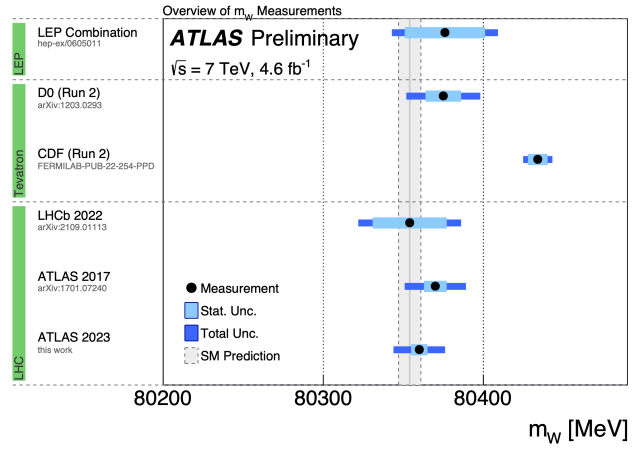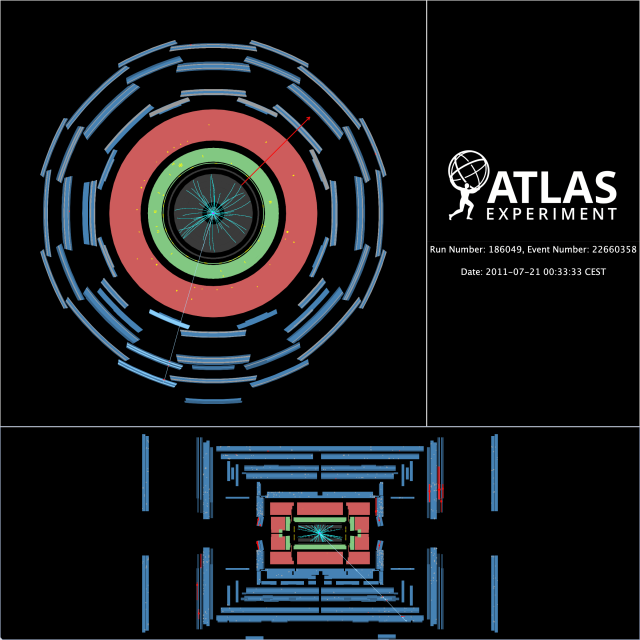ATLAS presents a new and precise measurement of the W boson mass
"The ATLAS experiment at CERN has presented a new, more accurate measure of the W boson mass, one of the fundamental particles that carry the weak nuclear force. The result is based on a sample of 14 million W boson candidates produced in proton-proton collisions at the LHC."
 A new measurement by the ATLAS collaboration was presented this week at the Rencontres de Moriond conference in La Thuile, Valle d'Aosta, Italy. It is the result of a re-analysis of the full data sample. It agrees with all previous measurements of the W mass, and is more accurate than all of them, with one exception: the measurement presented last year by CDF experiment at the Tevraton, Fermilab - even more accurate and deviating from the prediction of the Standard Model of particle physics, and also from the value obtained by ATLAS.
A new measurement by the ATLAS collaboration was presented this week at the Rencontres de Moriond conference in La Thuile, Valle d'Aosta, Italy. It is the result of a re-analysis of the full data sample. It agrees with all previous measurements of the W mass, and is more accurate than all of them, with one exception: the measurement presented last year by CDF experiment at the Tevraton, Fermilab - even more accurate and deviating from the prediction of the Standard Model of particle physics, and also from the value obtained by ATLAS.
The W and Z bosons are the carriers of the weak force, which is responsible for a type of radioactivity and initiates the nuclear fusion reaction that powers the Sun. The discovery of this particle at CERN 40 years ago helped confirm the theory of the electroweak force, which unifies the electromagnetic and weak forces, a cornerstone of the Standard Model. CERN's researchers who made the discovery possible were awarded the 1984 Nobel Prize in Physics. Since then, particle collision experiments at CERN and elsewhere have measured the mass of W boson with increasing accuracy.
In the Standard Model, the W mass is closely related to the strength of the electrophragic interaction and to the masses of the heavier fundamental particles, namely the Z boson, the top quark and the Higgs boson. In this theory, the mass of W must be 80354 million electron volts (MeV), with an uncertainty of 7 MeV. Any deviation of the measured mass from the Standard Model prediction would be an indicator of the existence of new physical phenomena - such as new particles or interactions. The more precise the mass measurement, the more sensitive it is to possible deviations.
ATLAS presented the result of the first measurement of the W mass in 2017, using data collected by the LHC in 2011 at an energy of 7 TeV. The result obtained, 80370 MeV with an uncertainty of 19 MeV. was in good agreement with the Standard Model prediction and with previous experimental results, including those from experiments at LEP (Large electron-positron collider), LHC's predecessor.
Last year, the CDF collaboration at Fermilab announced an even more accurate measurement, based on an analysis of its entire data set collected at the Tevatron. The result, 80434 MeV with an uncertainty of 9 MeV, deviates significantly from the Standard Model prediction and from the other experimental results, requiring further studies and measurements to try to identify the cause of the difference.
To achieve this result, ATLAS used an advanced data fitting technique to determine the mass, as well as newer and improved versions of the functions that describe the sharing of the proton momentum among its constituent quarks and gluons. In addition, the theoretical descirption of the W production processes was verified. To complete the study, the ATLAS collaboration re-analyzed the 2011 W boson sample, this time using the new method. The result, 80360 MeV with an uncertainty of 16 MeV, is 10 MeV lower than the previous result, 16% more accurate, and is in agreement with the Standard Model.

